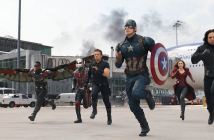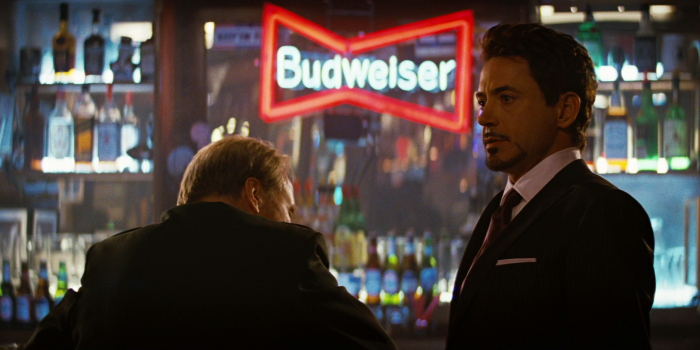
Cast: Filippo Pucillo, Donatella Finocchiaro, Beppe Fiorello
Director: Emanuele Crialese
Country: Italy | France
Genre: Drama
Official Trailer: Here
Editor’s Note: Terraferma is now open in limited release
“It wasn’t like this in my day,” is a phrase known well to any child who’s ever held counsel with a grandparent, even just a parent. Few things change less from generation to generation than the sense that the present is an inferior incarnation of the past, victim to the distractions and drawbacks of modern culture, that the “old days”, for all their own problems, were inherently better. More so than any other, cinema is an art form that allows us to quash that false sentiment: it is history recreated, the past preserved to be re-presented just as it happened upon a strip of celluloid. Or rather, now, on a hard drive. It wasn’t like that in my day.
The reality, of course, and that to which Crialese prominently points in his invocation of Visconti, is that this life has always been a struggle.
 It’s not by coincidence that Terraferma, the latest film from Italian director Emanuel Crialese, calls to mind Visconti’s La Terra Trema. He engages directly and determinedly with his nation’s past by way of Visconti’s image thereof; his own movie, in fact, can be seen almost as a direct response to the earlier one, not deterred by some six decades in the difference. Both films concern the fate of families whose lives depend on the fishing industry of their near-identically sized Sicilian towns; both, throughout, lament that industry’s impending death; both—crucially—by way of integral grandfather characters, recall the past as the site of greater fortunes. The reality, of course, and that to which Crialese prominently points in his invocation of Visconti, is that this life has always been a struggle.
It’s not by coincidence that Terraferma, the latest film from Italian director Emanuel Crialese, calls to mind Visconti’s La Terra Trema. He engages directly and determinedly with his nation’s past by way of Visconti’s image thereof; his own movie, in fact, can be seen almost as a direct response to the earlier one, not deterred by some six decades in the difference. Both films concern the fate of families whose lives depend on the fishing industry of their near-identically sized Sicilian towns; both, throughout, lament that industry’s impending death; both—crucially—by way of integral grandfather characters, recall the past as the site of greater fortunes. The reality, of course, and that to which Crialese prominently points in his invocation of Visconti, is that this life has always been a struggle.
His exposition of the lack of change the years have yielded allows Crialese to broaden the scope of his study, to look beyond the perpetual problems of these people to find the wider issues at play in the world around. He finds them at sea, in the wreckages of makeshift rafts ferrying immigrants to Italian shores, in the washed-up corpses of those who failed to make it. It’s here that his film invites easy comparisons to Kaurismäki’s Le Havre, though their ease doesn’t undermine their efficiency: in their respective atmospheres of neorealism and quasi-fantasy, Terraferma and Le Havre paint an overarching portrait of the moral imperative of this issue that transcends political policy. How, ask Kaurismäki and Crialese both, is it preferable to have children die in our waters than live on our land?
It’s here that his film invites easy comparisons to Kaurismäki’s Le Havre, though their ease doesn’t undermine their efficiency: in their respective atmospheres of neorealism and quasi-fantasy, Terraferma and Le Havre paint an overarching portrait of the moral imperative of this issue that transcends political policy.
 Beyond his parallels to Visconti and Kaurismäki, Crialese does manage an infusion of his own stylistic particularities. There’s a quiet comedy to his film, predicated mostly on the irony that arrives alongside the boatloads of tourists whose presence provides a new form of income to the decimated fishing community. The natives’ bending-over-backwards to please these visitors at the same time they deny the refugees constitutes an accommodation of the wealthy at the expense of the poor that’s as slyly amusing as it is sadly true to life. What’s sadder still, perhaps, is how much this influx signals the start of Terraferma’s problems, bringing with it a host of tangential subplots that do more harm than help in bolstering Crialese’s thematic investigations, his narrative diversions all-but marginalising the wider socio-political aims of the piece.
Beyond his parallels to Visconti and Kaurismäki, Crialese does manage an infusion of his own stylistic particularities. There’s a quiet comedy to his film, predicated mostly on the irony that arrives alongside the boatloads of tourists whose presence provides a new form of income to the decimated fishing community. The natives’ bending-over-backwards to please these visitors at the same time they deny the refugees constitutes an accommodation of the wealthy at the expense of the poor that’s as slyly amusing as it is sadly true to life. What’s sadder still, perhaps, is how much this influx signals the start of Terraferma’s problems, bringing with it a host of tangential subplots that do more harm than help in bolstering Crialese’s thematic investigations, his narrative diversions all-but marginalising the wider socio-political aims of the piece.
There’s an extraordinary scene not far from the end of the film where a beach strewn with sunbathing tourists is interrupted by the arrival of a tide of immigrants, live and dead. Set to a harrowing score, the close-up shots alternate crying black faces with shocked white ones, the contrast between the two and their circumstances providing one of Crialese’s more powerful invocations of the staggering inhumanity of the social system that could lead to such a scene. It’s in moments like these that Terraferma triumphs, building on the image—and its aspects that linger—of Visconti’s past to expose the greater issues of the present. If only they weren’t so few, and so fleeting.
[notification type=”star”]72/100 ~ GOOD. In moments Terraferma triumphs, building on the image—and its aspects that linger—of Visconti’s past to expose the greater issues of the present.[/notification]




Pingback: Manifestation Miracle Review()
Pingback: http://elinrosen.bloggplatsen.seelinrosen.bloggplatsen.se/gilla/?url=http://gaswatch.info()
Pingback: webcammodel worden()
Pingback: guitar picks()
Pingback: guitar picks()
Pingback: banheiras()
Pingback: groupone health source()
Pingback: trusted store()
Pingback: yspro.ne.jp()
Pingback: Green SEO Writing()
Pingback: recycle clothes for cash()
Pingback: chapter 7 bankruptcy carlisle()
Pingback: buy products wholesale()
Pingback: criminal defense attorney carlisle()
Pingback: all natural raspberry ketones()
Pingback: porno()
Pingback: esta()
Pingback: Prostate support supplement()
Pingback: walmart auto services mesa az()
Pingback: Ecograf()
Pingback: Best buy cell phone accessories()
Pingback: Leaflet printing()
Pingback: paintless dent repair training()
Pingback: movie2k()
Pingback: bikini luxe review()
Pingback: Habib Shekhanzai()
Pingback: ramalan bintang sagitarius()
Pingback: foundation repair()
Pingback: t shirt league of legends()
Pingback: dog playpen()
Pingback: QINGDAO DEJI()
Pingback: happy valentines day images()
Pingback: Seo()
Pingback: Melva()
Pingback: swap.com seller reviews()
Pingback: PREMIUM PROMOTIONS ON EXCLUSIVE CLUB CASINO()
Pingback: foredi()
Pingback: Escort()
Pingback: ebay deals nexus 10()
Pingback: essay on sleeping beauty mouth fucked()
Pingback: seo minneapolis()
Pingback: apple shooter()
Pingback: Go Here()
Pingback: learn more()
Pingback: Gascheck()
Pingback: hot threesome app()
Pingback: online branding()
Pingback: hardcore lesbia porn development()
Pingback: agen judi casino online()
Pingback: Freelance illustrator()
Pingback: Logo design australia()
Pingback: Elizabeth Swann Miller()
Pingback: wizey wo()
Pingback: sacred 3 trainer()
Pingback: Schluesseldienst Berlin()
Pingback: meaning of names()
Pingback: top ayurvedic retreats in kerala()
Pingback: asus driver downloade()
Pingback: fifthavenue()
Pingback: Blackcore Edge Pre Workout Pros and cons()
Pingback: reviews()
Pingback: popular italian names()
Pingback: stlpiky()
Pingback: Missy Thress()
Pingback: boom beach unlimited diamonds()
Pingback: boom beach cheats no survey()
Pingback: pest control cibolo tx()
Pingback: cheats for hungry shark evolution()
Pingback: Simple Drawing For Kids()
Pingback: Healthy eating busy schedule()
Pingback: sales training course singapore()
Pingback: Prebiotic()
Pingback: bottled water pump dispenser()
Pingback: Learning Photography in Chandigarh Nipun()
Pingback: Coto Mold()
Pingback: Cicely()
Pingback: kitten boarding naples()
Pingback: robot reviews()
Pingback: athletic greens()
Pingback: ebay affiliate()
Pingback: News Magazine()
Pingback: Buy Easy TV Money()
Pingback: take home pay calculator()
Pingback: Realtor BPO REO Real Estate Foreclosure()
Pingback: penny auction software()
Pingback: Vehicle GPS Tracker()
Pingback: garcinia cambogia 300()
Pingback: best edm 2016()
Pingback: Dr Field Harrison()
Pingback: Dr Field Harrison()
Pingback: Credit card debt()
Pingback: health()
Pingback: diaper bags()
Pingback: Spring Hill upholstery cleaning()
Pingback: bathroom scale 400 lb capacity()
Pingback: nose hair trimmer guide()
Pingback: Houston SEO()
Pingback: chapter 13 attorney mechanicsburg()
Pingback: tv antennas in san antonio tx()
Pingback: mh-23,mh-23 quick charger()
Pingback: hcg injections()
Pingback: MCA Total security()
Pingback: Cash 4 Clothes()
Pingback: punta cana golf()
Pingback: al3ab()
Pingback: fundraising()
Pingback: hail damage repair()
Pingback: landscape design Canberra()
Pingback: Cleaning Quoets()
Pingback: Eura()
Pingback: Peter Castellana()
Pingback: Thai Porn()
Pingback: Thai Porn()
Pingback: Compagnie de menage a Brossard()
Pingback: https://www.icct20worldcupschedule2016.com()
Pingback: roasting pan or dutch oven()
Pingback: overnight pet sitter in naples()
Pingback: fly swatter sword()
Pingback: Shirl Tickle()
Pingback: best mattresses 2016()
Pingback: moving labor()
Pingback: disco lights()
Pingback: Bob Creely()
Pingback: pet boarding()
Pingback: mobile strike hack()
Pingback: Foster Borger()
Pingback: homone therapy pregnancy()
Pingback: java training in pune with placement()
Pingback: USA Box Express LLC()
Pingback: Brain Power()
Pingback: Certified Hard Drive Destruction()
Pingback: ganador()
Pingback: https://www.facebook.com/sexiercom/()
Pingback: one year bullshit fraud investigations()
Pingback: Natural Gemstone Jewelry()
Pingback: safes for the home()
Pingback: porno()
Pingback: lake grande()
Pingback: jay servidio()
Pingback: Adele()
Pingback: lovetts lovin pet & home care()
Pingback: keepyourhair.cba.pl()
Pingback: dog care naples()
Pingback: installshield download()
Pingback: porno()
Pingback: porno()
Pingback: porno()
Pingback: posts about lipozene diet pills()
Pingback: kitten sitter()
Pingback: Cerchi nel grano Tracce d'intelligenza()
Pingback: forskolin reviews()
Pingback: Best drones for sale()
Pingback: jab comix()
Pingback: free bulk email marketing software()
Pingback: marketing social media()
Pingback: rancho cucamonga fitness boot camp()
Pingback: Denae()
Pingback: Chaga Tea()
Pingback: puppy sitter()
Pingback: animals()
Pingback: jew jokes()
Pingback: Full Article()
Pingback: Hotels in Colombo, ThumbsUp()
Pingback: over here()
Pingback: download proxies()
Pingback: Boon Lay Shopping Centre()
Pingback: rocketportuguese()
Pingback: Vancouver BC()
Pingback: candy saga()
Pingback: this post()
Pingback: Private investigator Pretoria()
Pingback: Bass samples()
Pingback: fat reducing pills()
Pingback: Fanclubdenhaag()
Pingback: seo Norge()
Pingback: hack clash royale gems()
Pingback: Alexis Texas Body Measurements()
Pingback: free daily horoscopes()
Pingback: jet stupid()
Pingback: The Lost Ways()
Pingback: Obsession Phrases Review()
Pingback: Ottawa Basement Finishing()
Pingback: Leiyao.net()
Pingback: best quotes()
Pingback: Bullpen sports cards()
Pingback: chlamydia()
Pingback: Obsession Phrases()
Pingback: http://pintupartisilipat.tumblr.com/()
Pingback: Window Replacement()
Pingback: frpornhub.easywomen.date()
Pingback: weed()
Pingback: babesandstars()
Pingback: City professional dentists stoke on trent()
Pingback: Quotes Daily()
Pingback: klimczak hair designers()
Pingback: transmission encryption destruction()
Pingback: Medix College Reviews()
Pingback: Mastering Witchcraft Reading()
Pingback: secret to toning your butt()
Pingback: business news in atlanta()
Pingback: appstore sms app()
Pingback: foro escorts()
Pingback: Managed VPS Hosting()
Pingback: Medix College Reviews()
Pingback: Medix College Reviews()
Pingback: nlyelp.bagging.top()
Pingback: pembroke furniture()
Pingback: poker online()
Pingback: Wire Cutting Machine()
Pingback: rug services()
Pingback: Long Island Lice removal()
Pingback: bountiful divorce lawyer()
Pingback: sleep aid for adults()
Pingback: SECRET SANTA GIFT()
Pingback: happinessanditscausescom()
Pingback: edarling()
Pingback: love quotes and sayings()
Pingback: leylandii()
Pingback: speargun()
Pingback: seo()
Pingback: mobile strike hack()
Pingback: www.gimwatch.date()
Pingback: www.christiantshirts.co()
Pingback: msr206 software()
Pingback: spearguns()
Pingback: alpine air purifier()
Pingback: send earnings()
Pingback: fuck you google()
Pingback: kopya icerik()
Pingback: social trends melbourne()
Pingback: overhead garage door installation austin()
Pingback: puno bus()
Pingback: Buy Beats exclusive rights()
Pingback: mill pepper salt peugeot()
Pingback: NBA Online Stream()
Pingback: SEO in Norway()
Pingback: Multilingual digital marketing()
Pingback: boligadvokater()
Pingback: como hacer app()
Pingback: China Engineering Equipment Network Co.,Ltd()
Pingback: class schedule maker()
Pingback: Zhongshan Optake Industrial Co., Ltd.()
Pingback: www.catsmi.pw()
Pingback: Casino()
Pingback: Online Casino()
Pingback: stumbleupon bot()
Pingback: edarling()
Pingback: computer pointspread predictions()
Pingback: massage()
Pingback: betting picks()
Pingback: ultimate demon lifetime discount()
Pingback: meniscus pain()
Pingback: get access to brazzers account()
Pingback: nathaniel()
Pingback: nordstrom coupon code()
Pingback: Mccoy()
Pingback: san antonio bail bonds()
Pingback: resume writing experts()
Pingback: http://www.tienda.fast.muplatas2.com/2015/01/wtfast.html()
Pingback: Dennis Schroeder 2015 Jersey()
Pingback: hackear clash of clans()
Pingback: Data Recovery Services()
Pingback: Data Recovery Services()
Pingback: see()
Pingback: Rafferty Pendery()
Pingback: Rafferty Pendery()
Pingback: tin nguyen()
Pingback: Rafferty Pendery Scientology()
Pingback: Samsung()
Pingback: follar()
Pingback: clash of clans pc windows 7()
Pingback: Affiliate Trax Discount()